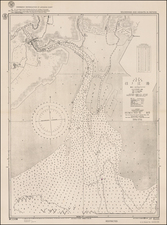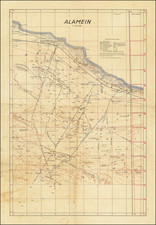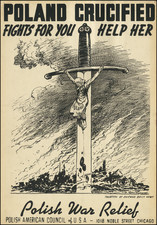Day-By-Day Accounting of the Brutal Fall of Sevastapol to Nazi Forces. Showing the Nazi Flag Planted on the Defence of Sevastapol Museum.
Immense contemporary annotated battle map of Sevastapol mapping the advance of the 132nd Jäger (Mountain Infantry) Division as they blitzed into the center of Sevastapol between the 22nd of June and the 1st of July.
This plan maps the final days of one of the most famous battles along the Eastern Front, important for the delays it caused Nazi forces in reaching and resupplying the siege at Stalingrad. The fortified city of Sevastapol, which German High Command referred to as "the most powerful land and sea fortress of all that has ever existed in the world" took seven months to fall. October 1941 to May 1942 saw attempted various Axis offensives and Soviet counteroffensives. Eventually, the Axis mounted a massive attack in June of 1942 that saw units approach the city from the north and southeast and a month of heavy fighting before the fall of the city.
The map shows the positions and routes taken by infantry (Jäger) divisions during the final month of the siege. A day-by-day mapping of the positions of the 132nd Infantry Division are shown on the 22nd, 26th, 28th, 29th, 30th, and 1st. The positions of the 42nd and 72nd Infantry Regiments (part of the 132nd) are given particular consideration.
The 132nd approached the city from the densely forested and heavily mountainous northeast. Initially deadlocked north of the city in early June, the 132nd nearly reached a breaking point around the 8th of June, but the diversion of German bombers to their support stabilized their position. Finally, they destroyed their Soviet opponents around the 10th of June, and were able to cross the Belbek River (just below the join between the top and middle sheets on the map) at that point. From there, they advanced southwards, slowly breaking through further lines for the next few days. Finally, the 132nd were able to aid in the destruction of all Soviet forces north of Sevastapol Bay between the 18th and the 20th, reaching the coast just north of the bay as shown on the map.
On the 22nd, the 132nd regrouped east of the bay to push towards the city and its eventual collapse. They rejoined the XXX Corps south of the city and proceeded westwards from there. This map shows that by the 30th, they were on the outskirts of Sevastapol, by 14:00 on the first they planted a flag at the memorial for the Crimean War Siege of Sevastapol, and by 17:00 they were a few blocks from the coast. Scattered resistance remained in the city until the 4th, but this map stops its record on the 1st.
The Siege of Sevastapol
The arrival of Axis forces in Crimea in the fall of 1941 led to the eradication of Soviet positions throughout the peninsula, but the fortress-city of Sevastapol refused to fall. Axis troops repeatedly tried taking the city between October and November 1941 but did manage to seal the city off temporarily. However, in December, the Soviets landed at Kerch, establishing a bridgehead on the peninsula and strengthening their defense.
The Soviet hold on Sevastapol proved formidable for the Nazis, as it allowed the Soviets to attack Nazi-held seafront in the western Black Sea. Further, the siege drew troops away from the rest of Operation Barbarossa; thus, the German High Command decided to order the completion of the siege.
The start of June 1942, saw a renewed offensive. Led by the 132 Infantry Division, German troops approached the Bay of Sevastapol from the north. Meanwhile, the XXX Corps kept the defenders of the city at bay on the south side. Around the 20th of June, Soviet resistance collapsed and the German troops entered the city on the 1st of July.












![[Napoleon]. A Sketch of the Russian Campaign in 1812](https://storage.googleapis.com/raremaps/img/small/63426.jpg)



![Basic Field Manual | Elementary Map and Aerial Photograph Reading [Booklet with double-sided folding map]](https://storage.googleapis.com/raremaps/img/small/90597.jpg)